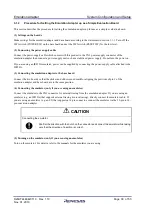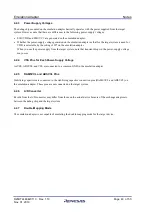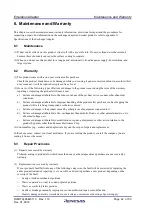
Emulation Adapter
Notes
R20UT4460EJ0110 Rev. 1.10
Page 39 of 53
Nov. 01, 2019
4.Notes
4.1
Setting Option Bytes
Although the specifications of the option bytes of the debug chip which is mounted on the emulation adapter are
the same as those of the target device, the actual settings at the time of shipment may differ.
Specify appropriate values for the option bytes of the debug chip according to the user’s manual for the target
device.
In particular, the values of the following option bytes must be specified to suit the device to be emulated.
4.1.1
OPBT9
OPBT9 is an option byte which only requires setting in the case of the debug chip. Set OPBT9 according to the
device to be emulated before starting debugging.
Option byte OPBT9:
Address: FF32 00A4H
Default value: FFFF FFFAH (for emulation of the E2UH)
Setting value: FFFF FFF8H (for emulation of the E2H)
4.1.2
OPBT3
OPBT3 defines the CPUs which are to be enabled. Since the debug chip emulates the E2UH, which has six CPUs,
disable the unnecessary CPUs (set the PEx_DISABLE to 1) through the setting of OPBT3.
4.2
Notes on Differences between the Actual Device and the Emulation
Adapter
4.2.1
Current Drawn
When the emulation adapter is in use, current drawn may differ from that for the actual device. Thus, the customer
should use the actual device in a final evaluation before mass production and judge the suitability of adopting the
product on that basis.
4.2.2
Oscillator
The emulation adapter does not support clock input from an oscillator on the target system. The main clock
oscillator on the emulation adapter is used as the main clock. The emulation adapter only supports the main OSC
crystal resonator but not external clock input.
Proceed with final evaluation to confirm operation of the target system after mounting the actual device and while
using the oscillator on the target system.















































